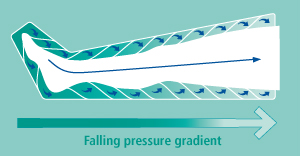











|
|
The Intermittent Compression
From the Beginning up to the Present
The History
Mode of Actions and Indications
|
 |
|
Force and suction pump,
Paris 1834
|
 |
|
Fig. 1
Device for high-pressure massage
Kassel, 1909
|
 |
|
Fig.2
Hammesfahr, 1929
|
 |
|
Fig.3
Cross section of a 1-chamber-system
|
 |
|
Fig. 4
Cross section of a conventional multi-chamber-system.
The chambers are inflated in succession.
|
|

|
|
Fig. 5
Cross section of a multi-chamber-system with overlapping air chambers.
The overlapping air chambers generate a gliding pressure wave with high efficiency.
|

|
|
Fig.6
lympha-mat GRADIENT
12-level system
|
|
•
•
•
•
•
•
•
•
•
•
•
•
•
•
•
•
•
|
Indications
thromboembolic prophylaxis
post-thrombothic syndrome
ulcus cruris
venous oedema
post-traumatic oedema
minor lymphatic oedema
lipoedema
mixed forms of oedema
peripheral arterial occlusive disease
under strict observation
sensory disturbance caused by
hemiplegia
Contra-indications
decompensated cardiac insufficiency
extensive thrombophlebitis,
thrombosis or suspected thrombosis
erysipelas
severe unstabilised hypertension
acute soft-part-trauma of extremities
neuropathy
occlusive processes in the sector
of lymphatic drainage
|
|
|
Table 1
|
|
|
From the Beginning up to the Present
Next to bandages and compression stockings, instrumental intermittent compression has been standard for years now in the physical treatment of venous and lymphatic diseases.
Numerous studies documented its lasting efficiency, which increased its significance over the last years. Also the field of indication of this form of therapy has enlarged enormously.
go to top
|
|
The history
The first recorded publication on the application of pneumatic treatment of extremities dates back to 1834. It was about a "force and suction pump": suction to generate a reactive hyperaemia, force to reduce the volume of the extremities.
Another origin of instrumental therapy with rhythmic compression is the mercury massage. In 1902, for the treatment of arm oedema Hofmeister recommended the immersion of the affected extremity in an iron cylinder filled with mercury.
In 1909, the first of today’s commonly known devices for instrumental intermittent compression was developed in Kassel, with a filling and draining treatment sleeve, called high-pressure massage (Fig. 1).
In 1929, Hammersfahr (Magdeburg) described a rhythmically filling and draining "air chamber" (Fig. 2), which he used for the mechanical support of the peripheral metabolism and the prevention of thrombosis.
Also in 1929, Schede (Leipzig) described a modified gluteal massage, and, in 1932, his first compression boots.
In the 1960s, the first commercial manufacturing of 1-chamber-air-systems was realized in the United States by Conrad Jobst (Erlangen). This treatment method was standard of therapy for many years (Fig. 3).
As a result of the growing use in therapy and on the basis of many suggestions from medical experts, a new type of device was developed, the multi-chamber-system. In this system, the treatment sleeves consist of multiple air chambers which are firmly connected (Fig. 4).
go to top
|
|
The 1-chamber-system became less important after the superiority of the new multi-chamber-system was confirmed.
In the generation of newly developed devices, the treatment sleeve is no longer filled with just one tube and doesn’t compress into depth. Instead, three adjacent air chambers generate a pressure build-up from distal to proximal. Accordingly, with the multi-chamber-system the oedema fluid is mobilised ascendingly.
The chambers are inflated in such a way that the next chamber is filled with air only after the one before has attained the desired treatment pressure. Once all the chambers are filled, the air is release simultaneously. After an interval, the inflation cylcle begins once again. Thus, a reflux of fluid is ruled out.
One of these inventions was the pressure-wave-therapy (Wave) with 12-air-chambers by Strehler (Switzerland) in 1968.
The first ever pressure controlled overlapping 12-level system for instrumental intermittent compression was developed by Eck (Germany) in 1979. This system was improved by gradient pressure in 1994 (Fig. 6).
go to top
|
|
Instead of the treatment sleeves used up to then with equal pressure from distal to proximal, the gradient system realizes an ascending pressure decline. (Fig. 6)
The fluid mobilized in the high pressure range may pass unhamperedly through the low pressure levels, which ensures a continuous flow through the entire extremity.
For the patient, the average pressure load is lower than with conventional devices. An improved decongestion of the lower extremities is reached by leg and hip sleeves. The proximal part of the oedema is also decongested, and the treatment area considerably enlarged.
Today, systems of intermittent pneumatic compression are manufactured worldwide. The main difference is to be found in the arrangement and number (1 to 12) of the treatment sleeve’s air chambers. (Not the same as the number of air chambers in all therapy devices.)
go to top
|
|
Mode of Actions and Indications
The aim of the functional principle of the gradient intermittent compression is not just the mere re-absorption of ultra-filtration into the venous system, but to carry absorbed protein into the lymphatic system.
The gradient pressure causes a movement from distal to proximal regions in the intercellular space, with healty vessels for absorption. The venous and lymphatic drainage is considerably improved. In the leg, the calf muscle pump is passively simulated. The increase of the fluid speed of the venous blood also has an anti-thrombotic effect. Also an increase in the fibrolynitic activity in the blood and venous septum, a reduction in the haematocrit and an increase in the coagulation factor VIII as well as an increase of anti-coagulatory protein C have been proven after application of intermittent pneumatic compression. In case of chronic venous insufficiency, the cutaneous microcirculation is improved.
Indications for intermittent pneumatic compression are the strongly developed, chronic venous insufficiency and lymph respectively lipoedema. Peri- and post-operative thrombosis prophylaxis is another important area of application of this therapy method. Various other illnesses, accompanied by oedematous swelling of extremities, can also be treated with intermittent pneumatic compression.
Contra-indications are acute surface and deep thrombophlebitis, inflammatory dermatological changes (except ulcus cruris) and decompressed cardial insufficiency due to the additional volume load on the heart caused by the mobilisation of oedema fluid (Table 1).
Systems for intermittent pneumatic compression consist of a compressor and the treatment sleeves. The data for duration of therapy, treatment pressure and intervals are entered into the compressor. Depending on the patient‘s requirements, the therapy is carried out several times a week. The therapy is usually started with low treatment pressure which can be increased in accordance with the patient’s toleration.
A prescription of home therapy makes the patient independent and enables the patient to receive therapy at weekends and on holidays etc.
Depending on the symptoms, either the 3-level gradient system vasoflow, the 6-level gradient system comprimed or the 12-level gradient system lympha-mat can be applied. With the 3-level gradient system, the pressure is transported mainly into depth, which makes it perfectly suited for therapy of venous diseases. The 12-level gradient system is suitable for all therapy areas of intermittent pneumatic compression, in particular for lymphoedema therapy.
Sleeves are available for arms, legs and hips. The equipment is constructed for the simultaneous application of two or even three sleeves.
lympha-mat GRADIENT / vasoflow GRADIENT are recognized aids, to be prescribed and to be accounted for by practices according to EBM/GOÄ 30401.
go to top
|
|
|
|
|
|













